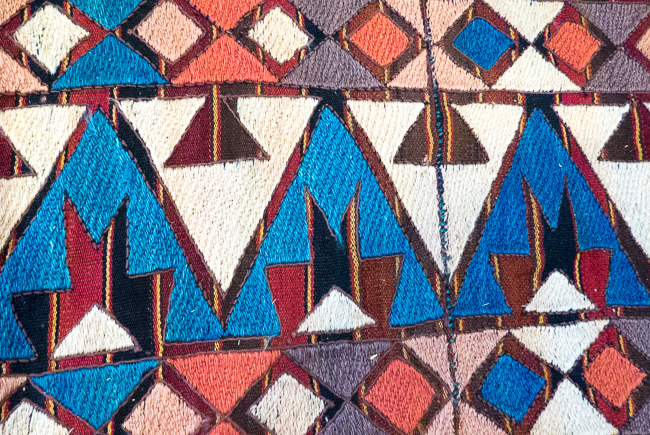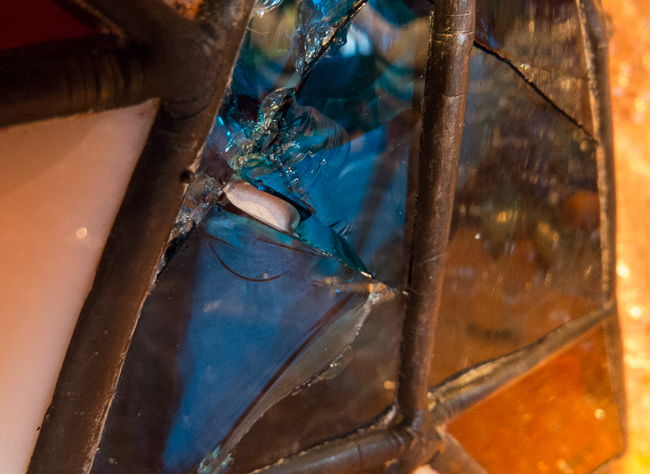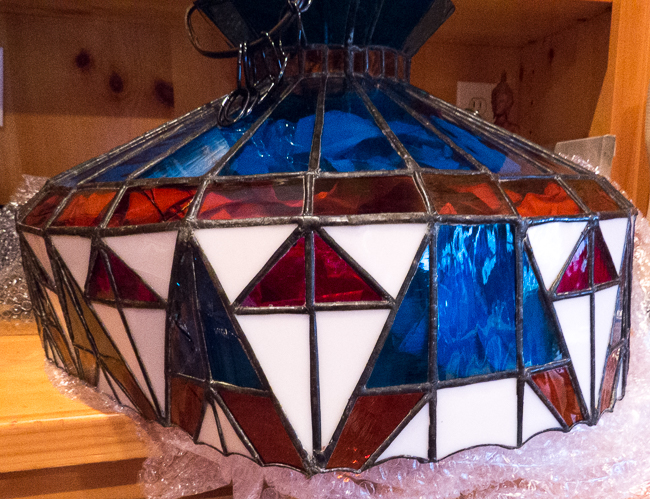The two women held up a large item partially encased in bubble wrap. “Where does this go?” they asked.
I stared. It took a second to recognize the stained glass lamp – because one side of it was caved in.
“It hangs above the dining table,” I said. “But … it’s broken.” I was running towards them, not quite believing this had happened.
The lead that holds the pieces together was bent, and a half-dozen of the glass pieces were broken.
When the movers packed out the house, this was the one item that I’d pointed out as very very special and in need of extreme care.
Dad made it for me.
He had made Tiffany lamps from patterns, but I wanted one custom-designed to match my Afghan rug. He came up with a design that echoed the geometric shapes in the carpet.

Matching art glass colors to the natural-dyed wool was difficult, and we went back and forth by email for awhile before agreeing on four colors.
It was the last stained glass lamp Dad ever made. A possession that was truly irreplaceable.
Art glass, whether stained glass or the fusible kind that I use, is handmade. The few companies that make it have their own formulas for the colors they sell, and so each color is unique to its maker. Although the companies are fairly consistent in their color production, over time they may change their formulas.
And sometimes they go out of business – like Spectrum Glass, which produced much of the stained glass used by hobbyists like Dad. Matching the colors that Dad so carefully chose will not be easy.

In addition to the design and the glass itself, this lamp has another unique quality that will make it hard to repair.
Lamps are built on styrofoam forms, which hold the shape as the pieces are put together. Each form comes with a paper pattern that’s used to cut the glass. When Dad made this lamp, he drew the design to the dimensions of a Tiffany lamp that he’d previously made for my sister, intending to use the same form.
As he began to put it together, though, he was puzzled. The pieces didn’t fit on the form.
Dad was a careful worker. He measured and drew with precision. But he was in his 80s, so he thought maybe he’d just made a mistake.
He checked the pattern and the cut pieces. Everything lined up. Yet somehow, the pattern didn’t match the form.
Then he realized what had happened.
The form was stored in his garage workshop. In Sun City, Arizona, temperatures get to 110 or more. Over a few years, the heat shrunk the styrofoam, and the form no longer matched the pattern size.
Dad being Dad, he didn’t throw up his hands and walk away. He adapted, replacing two sections with one and incorporating the extra panel into the design.
So on this lamp, if you look closely you’ll see one section that’s different than the rest.
Artisans of many cultures are said to deliberately make a small mistake in their work – Amish quilters, Persian rug makers, Turkish shipbuilders. This act is attributed to their belief that there is only one Creator of perfection. A human creation cannot be perfect; it would be an affront to God.
Though Dad didn’t make the mistake on purpose, the irregular section of this lamp is a reminder to me of the very human hands that made it.
Hands that were stilled in March 2010.
Hands that cannot repair this lamp, as they repaired so many broken things in 89 years.
Stained glass has been made for many centuries; its use ebbed and flowed with the tides of economics and design fashion. The value of handmade glass has persisted.
Today I found other hands that can restore this lamp. The artisan is descended from Kiowa Native Americans.
When Dad’s lamp hangs above my table again, it will be a reminder of all that is handed down from one generation to the next, across cultures and in the face of tremendous change.
Today’s penny is a 2008, the year that Dad made this lamp.

So happy you found someone to repair the lamp. What a treasure it is.